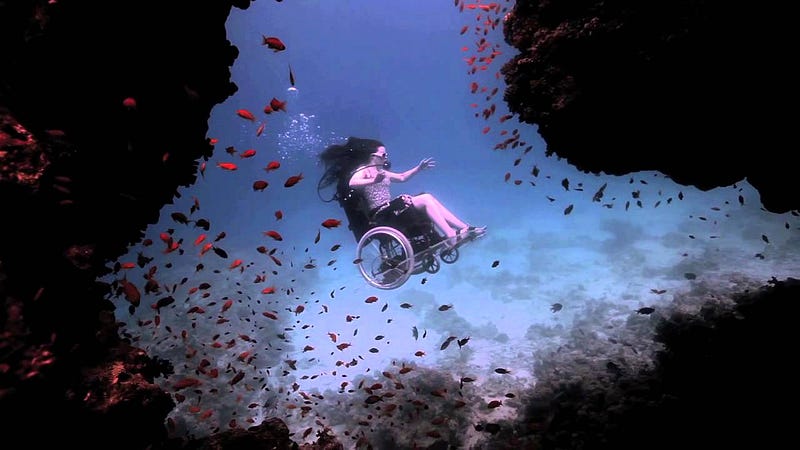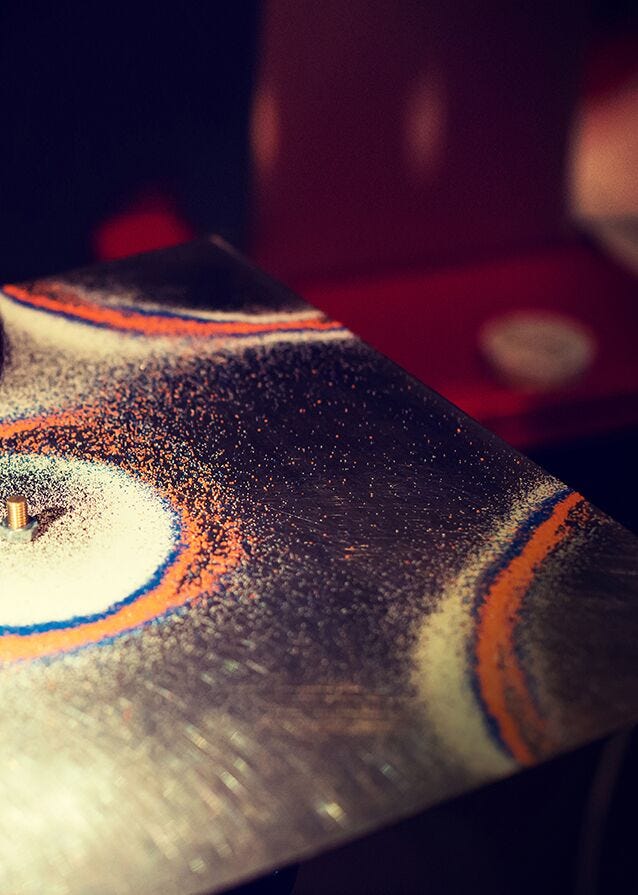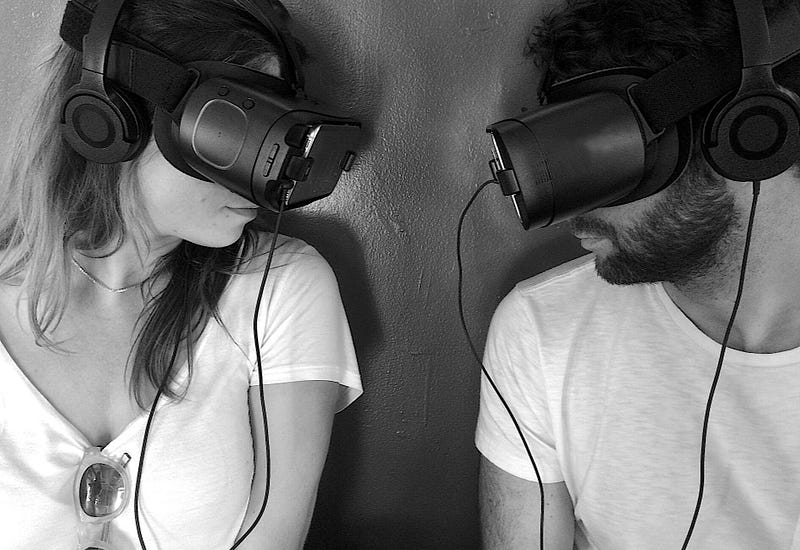Disability, Digital, and Disruption
Tasting sound, feeling stars, haptic fish — how artists with disabilities are re-imagining art and tech
Despite the negative narratives about what we call “disabled artists” in the UK, such creators have always stretched boundaries, challenged stereotypes and created change. Increasingly, they are using a wide range of digital and new technologies to do so. As the senior producer for UK-based Unlimited, the world’s largest disabled-led arts commissioning program, I see many at the cutting edge of such work.
What does real inclusion mean?
A year or so back, I went to an exhibition in Sheffield called The Body Electric. The exhibit was fascinating in many ways, but one crucial collection stood out: the story of Cindy, a quadruple amputee given a $90,000 high tech myoelectric “hand.” Did this magically solve her access issues? No. She found it “heavy, awkward and imprecise,” preferring cheap homemade hacks such as inserting eyeliner in a foam tube or creating silicon attachments for a traditional knife and fork.
There is a saying in the disability movement —“nowt about us, without us” —and I think it’s probably more important in the field of technological innovation than anywhere else. Don’t get so high on inventing something that you forget to include the input of the very person you are inventing it for.
It’s the same with many of the access solutions that magically come up on my Facebook feed. Enormous tech-gloves that turn sign language into speech! Wow. They aren’t going to look inconspicuous at all! Let’s think about it for a moment: If either captions or sign language were included within our culture more frequently, would these be necessary? True, they might enable a deaf person to “speak,” but how would the deaf person then process the spoken response? Some of the tech we are in such a rush to create might seem to solve a problem, but it’s not always the right one. And, sometimes, the solution causes more problems than it solves.
Developments in arts and tech often place disabled people as recipients rather than creatives. As new technology shapes the future of culture, I’d urge us all to play our part in ensuring that disabled artists are at the forefront of innovation.
 Artist Sabrina Shirazi in a still from OPUS; her head and
shoulders are coated in white and she is eating a lemon
Artist Sabrina Shirazi in a still from OPUS; her head and
shoulders are coated in white and she is eating a lemonThe importance of access
Unlimited has supported and shortlisted many artists working with digital and new technologies.Take Sabrina Shirazi’s work on OPUS — uniting sound, image, and taste by harnessing congruent elements. We supported a series of workshops in which deaf and hearing people tested her bone conduction gobstoppers, which enabled us to hear through our teeth whilst “tasting” different sounds. Unlimited’s 2012 sensation was Sue Austin’s Underwater Wheelchair (available in Virtual Reality, 360 degree, and standard installation formats).
 A scenic
image from Sue Austin’s 360 video piece Underwater shows a woman in a wheelchair
underwater (with an oxygen tank), swimming with fish
A scenic
image from Sue Austin’s 360 video piece Underwater shows a woman in a wheelchair
underwater (with an oxygen tank), swimming with fishSue’s work is interesting both from a technological perspective and also in thinking about access. She gained funds to research just how such immersive work can be created and displayed — by everyone and for everyone. Her team’s research resulted in a commercially viable, robust system of integrated 360° recording, editing and display technologies for small arts, community, and educational venues, portable and accessible headsets plus affordable, transportable installations so that work can be made by — and seen by — audiences currently excluded from accessing arts venues due to disabling physical, psychological, and financial barriers. Remember, access isn’t just about captions and audio description — although those are important, too!
But, actually, it’s even more than that. Access isn’t just about access to individual artworks, it’s about access to ambition, to seeing reflections of yourself. Watching Sue gives a sense of freedom, liberation, transformation — a far cry from how disability is usually portrayed.
Access is also about involvement. It might mean access to participating in the arts or even access to the possibility of being an artist. Ultimately, it’s about access to being seen as part of humanity.
When we deny people access, we treat them as lesser. We say they aren’t as valued, as important, as human as everyone else. We deny them what they need. And this is what you do every single time you forget to put on captions. Don’t have time to alt tag an image. Don’t bother with an audio description because you think it doesn’t really matter.
The imagination of artists
In 2015, Unlimited was a key partner — with ANAT, Watershed and Access2Arts—in Unfixed, an art and tech project across Australia and the UK that centered disabled artists in conversations about the intersection of art, technology, and disability. Since then we’ve shortlisted and funded yet more work by artists showing increasing confidence in their explorations.
Take Juliet Robson, for example, who has worked with a meteorologist, a mathematician, and astrophysicist for hertz, a multipart installation which makes visible and tactile the inaudible symphony of the stars and the earth’s hidden resonances, inspired by her insatiable curiosity and her experiences of visibility/invisibility and tremors.
 Juliet
Robson’s hertz explores the
vibrations and audio frequencies that surround us. This still is a closeup of a sheet of painted
metal.
Juliet
Robson’s hertz explores the
vibrations and audio frequencies that surround us. This still is a closeup of a sheet of painted
metal.Or Felix Peckett, who experiences Tourette Syndrome and, with it, a heightened awareness of sonic access. Peckett is working on a participatory game where players use the “Goldilocks Mixer” to find the perfect sonic blend for a specific group, where all can be included and none forced out.
Or Richard Butchins, who won the Interactive Award at Sheffield International Documentary Festival for Voice of the Unicorn, an installation involving disabled dancer Kazuyo Morita and Atelier Corners, a group of autistic artists based in Osaka. This award recognises new forms of interactive storytelling and honoured the project’s originality in its approach to form, storytelling and delivery, and was key to the work showing at Noviembre Electronico in Buenos Aires, Argentina, late last year.
 Richard
Butchins’ The
Voice of the Unicorn is a collaboration with disabled dancer Kazuyo Morita and three
prominent autistic Japanese artists: Yasuyuki Ueno, Mami Yoshikawa, and Koji Nishioka. In this
photo, audience members explore multiple video screens and a wall projection, all part of the
installation.
Richard
Butchins’ The
Voice of the Unicorn is a collaboration with disabled dancer Kazuyo Morita and three
prominent autistic Japanese artists: Yasuyuki Ueno, Mami Yoshikawa, and Koji Nishioka. In this
photo, audience members explore multiple video screens and a wall projection, all part of the
installation.Or Bekki Perriman’s The Doorways Project, a sonic installation created by those living on the streets, played out in doorways. This work is not just perfect for visually impaired people, but, in this world of constant moving image, a provides a real chance for all to stop and focus down. It’s incredibly moving — and, of course, transcripts are available for those who can’t access audio. Bekki used to sleep in doorways herself — the numbers of disabled people who also experience homeless is significant — and it’s her unique insight into this experience that makes the work so powerful. Access is about making work accessible to all, but sometimes only disabled artists can make the experiences of disability accessible, highlighting the way in which the world appears to perceive and value — or not value — our humanity.
What’s next?
We commission our next set of artworks in March 2019. Currently within our shortlist we have some of the most innovative works we’ve heard about to date, all arising from the lived experience of the artists themselves:
Jane Gauntlett recently presented In My Shoes: Intimacy, a 360-degree experience for two and is shortlisted for TrueLove, a theatre experience set in Mixed Reality (Magic Leap) about ferality, social boundaries, and the impact of technology and data on human connection. A combination of game, interactive theatre, and interactive technology, it hones in on the importance of human connection in survival and asks is knowledge power? And, if so, do we want it?
 A still
from Jane Gauntlett’s interactive project True Love
shows a blond woman and a brown-haired, bearded man lying down and facing each other, wearing VR
headsets.
A still
from Jane Gauntlett’s interactive project True Love
shows a blond woman and a brown-haired, bearded man lying down and facing each other, wearing VR
headsets.John Finn is profoundly deaf and also describes himself as having a degenerative eye condition. He pioneered the use of motion capture technology to animate British Sign Language and is now developing his skills in haptic art to create a simulacrum fish tank where you can both see and then “feel” a variety of highly individualized fish
Another deaf artist, Jonny Cotsen, is developing “Hearing Hearing” Aids, devices that immerse the audience into the fully sensory life of a deaf person rather than just alter the volume of sound.
Shifting the sector
None of the works above are developing in isolation. At the heart of each are partnerships and collaborations with other artists, technologists, and organisations. Yet each is led unashamedly by disabled artists, and it’s their unique lived experience that make the work so distinctive.
Supporting others to lead is essential, especially those who are different than the “usual” dominant tech crowd, yet both the arts and the tech sectors can often be hard to change. It takes confidence to step back to allow others to come forward. Is the art and tech sector ready to play a supportive role to true innovation and adapt for access when required? Increasingly, we are seeing organisations say, ‘yes.’
Want to be part of it? Our top three tips:
- Think about what you can learn, not just what you can pass on.
- Shift from fixed thinking — there is never only one way to do anything. If you hit a barrier, think creatively about the benefits of doing things differently.
- Try thinking from a different perspective — if you aren’t part of the solution, perhaps you are part of the problem?
Jo believes is the senior producer for Unlimited, the world’s largest commissions programme for disabled artists; delivered by Shape and Artsadmin, funded by ACE, Arts Council Wales, Spirit of 2012 and British Council. Contact: joverrent@weareunlimited.org.uk | Twitter: @Joverrent
Immerse is an initiative of the MIT Open DocLab and The Fledgling Fund, and it receives funding from Just Films | Ford Foundation and the MacArthur Foundation. IFP is our fiscal sponsor. Learn more here. We are committed to exploring and showcasing media projects that push the boundaries of media and tackle issues of social justice — and rely on friends like you to sustain ourselves and grow. Join us by making a gift today.